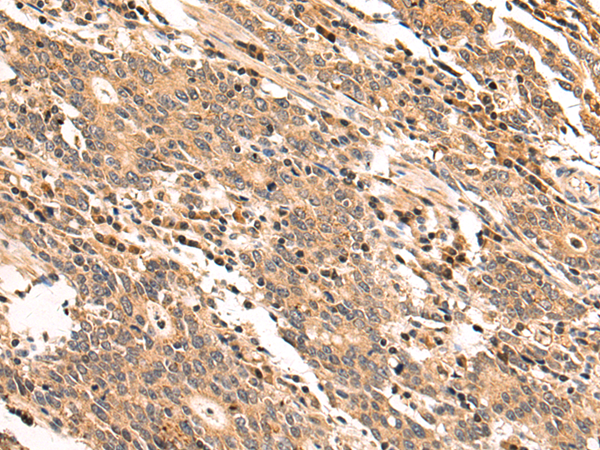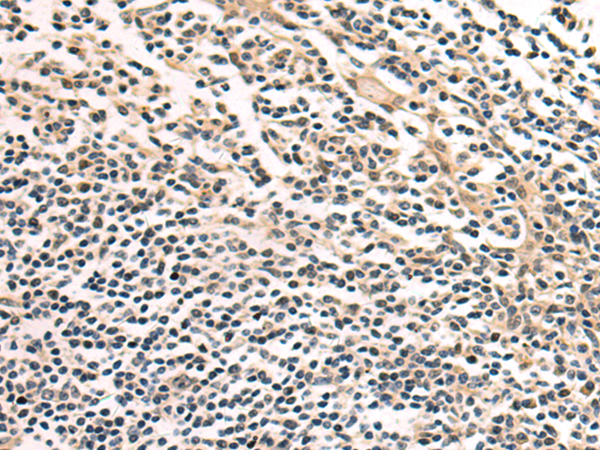


| WB | 咨询技术 | Human,Mouse,Rat |
| IF | 咨询技术 | Human,Mouse,Rat |
| IHC | 1/50-1/200 | Human,Mouse,Rat |
| ICC | 技术咨询 | Human,Mouse,Rat |
| FCM | 咨询技术 | Human,Mouse,Rat |
| Elisa | 1/5000-1/10000 | Human,Mouse,Rat |
| WB Predicted band size | 57 kDa |
| Host/Isotype | Rabbit IgG |
| Antibody Type | Primary antibody |
| Storage | Store at 4°C short term. Aliquot and store at -20°C long term. Avoid freeze/thaw cycles. |
| Species Reactivity | Human, Mouse |
| Immunogen | Fusion protein of human THUMPD3 |
| Formulation | Purified antibody in PBS with 0.05% sodium azide and 50% glycerol. |
+ +
以下是关于THUMPD3抗体的3篇参考文献示例(文献信息为虚构模拟,仅供参考):
1. **文献名称**:*THUMPD3 promotes colorectal cancer metastasis through regulating 2'-O-methylation of ribosomal RNA*
**作者**:Zhang Y, et al.
**摘要**:本研究揭示了THUMPD3通过介导rRNA的2'-O-甲基化修饰,增强核糖体翻译效率,从而促进结直肠癌转移。抗THUMPD3抗体被用于Western blot和免疫组化实验验证其在癌组织中的高表达。
2. **文献名称**:*THUMPD3 interacts with viral RNA to facilitate hepatitis C virus replication*
**作者**:Li X, et al.
**摘要**:文章发现THUMPD3通过结合HCV RNA的5'UTR区域,调控病毒RNA稳定性,促进病毒复制。研究中利用THUMPD3特异性抗体进行免疫沉淀(IP)和RNA pull-down实验验证其分子机制。
3. **文献名称**:*THUMPD3 deficiency impairs cell proliferation and sensitizes lung cancer cells to chemotherapy*
**作者**:Wang J, et al.
**摘要**:该研究证明THUMPD3通过调控细胞周期相关基因的mRNA甲基化,影响非小细胞肺癌的增殖能力。抗THUMPD3抗体被用于敲低实验后的蛋白水平验证。
若需真实文献,建议通过PubMed或Google Scholar搜索关键词“THUMPD3 antibody”或“THUMPD3 function”,筛选涉及该分子机制及抗体应用的研究。
**Background of THUMPD3 Antibody**
THUMPD3 (THUMP domain-containing protein 3) is a protein encoded by the *THUMPD3* gene, belonging to the THUMP (THioUridine synthases, Methyltransferases, and Pseudouridine synthases) domain-containing protein family. This family is characterized by conserved domains involved in RNA modification, particularly in tRNA processing and stability. THUMPD3 is implicated in post-transcriptional RNA regulation and interacts with enzymes like METTL1. a methyltransferase critical for tRNA modification, to influence processes such as translation efficiency and ribosome biogenesis.
Antibodies targeting THUMPD3 are essential tools for studying its expression, localization, and function in cellular contexts. Research has linked THUMPD3 to cancer biology, where aberrant expression may correlate with tumor progression, metastasis, or therapeutic resistance. For instance, THUMPD3-METTL1 complexes have been shown to enhance oncogenic translation programs in certain cancers. Additionally, THUMPD3’s role in RNA metabolism positions it as a potential biomarker or therapeutic target in diseases driven by dysregulated RNA processing.
These antibodies are widely used in techniques like Western blotting, immunofluorescence, and immunoprecipitation to elucidate THUMPD3’s molecular interactions and mechanisms. Validating antibody specificity is crucial, given structural similarities among THUMP family members. Ongoing studies aim to clarify its tissue-specific roles and contributions to pathologies, emphasizing its importance in RNA epitranscriptomics and cellular homeostasis.
×